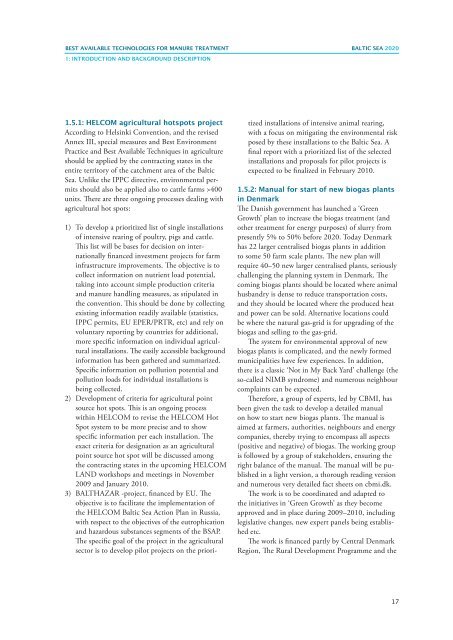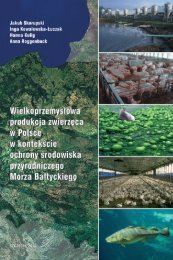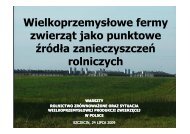best available technologies for manure treatment - Baltic Green Belt
best available technologies for manure treatment - Baltic Green Belt
best available technologies for manure treatment - Baltic Green Belt
You also want an ePaper? Increase the reach of your titles
YUMPU automatically turns print PDFs into web optimized ePapers that Google loves.
Best Available Technologies <strong>for</strong> <strong>manure</strong> <strong>treatment</strong> baltic sea 2020<br />
1: INTRODUCTION AND BACKGROUND DESCRIPTION<br />
1.5.1: HELCOM agricultural hotspots project<br />
According to Helsinki Convention, and the revised<br />
Annex III, special measures and Best Environment<br />
Practice and Best Available Techniques in agriculture<br />
should be applied by the contracting states in the<br />
entire territory of the catchment area of the <strong>Baltic</strong><br />
Sea. Unlike the IPPC directive, environmental permits<br />
should also be applied also to cattle farms >400<br />
units. There are three ongoing processes dealing with<br />
agricultural hot spots:<br />
1) To develop a prioritized list of single installations<br />
of intensive rearing of poultry, pigs and cattle.<br />
This list will be bases <strong>for</strong> decision on internationally<br />
financed investment projects <strong>for</strong> farm<br />
infrastructure improvements. The objective is to<br />
collect in<strong>for</strong>mation on nutrient load potential,<br />
taking into account simple production criteria<br />
and <strong>manure</strong> handling measures, as stipulated in<br />
the convention. This should be done by collecting<br />
existing in<strong>for</strong>mation readily <strong>available</strong> (statistics,<br />
IPPC permits, EU EPER/PRTR, etc) and rely on<br />
voluntary reporting by countries <strong>for</strong> additional,<br />
more specific in<strong>for</strong>mation on individual agricultural<br />
installations. The easily accessible background<br />
in<strong>for</strong>mation has been gathered and summarized.<br />
Specific in<strong>for</strong>mation on pollution potential and<br />
pollution loads <strong>for</strong> individual installations is<br />
being collected.<br />
2) Development of criteria <strong>for</strong> agricultural point<br />
source hot spots. This is an ongoing process<br />
within HELCOM to revise the HELCOM Hot<br />
Spot system to be more precise and to show<br />
specific in<strong>for</strong>mation per each installation. The<br />
exact criteria <strong>for</strong> designation as an agricultural<br />
point source hot spot will be discussed among<br />
the contracting states in the upcoming HELCOM<br />
LAND workshops and meetings in November<br />
2009 and January 2010.<br />
3) BALTHAZAR -project, financed by EU. The<br />
objective is to facilitate the implementation of<br />
the HELCOM <strong>Baltic</strong> Sea Action Plan in Russia,<br />
with respect to the objectives of the eutrophication<br />
and hazardous substances segments of the BSAP.<br />
The specific goal of the project in the agricultural<br />
sector is to develop pilot projects on the prioritized<br />
installations of intensive animal rearing,<br />
with a focus on mitigating the environmental risk<br />
posed by these installations to the <strong>Baltic</strong> Sea. A<br />
final report with a prioritized list of the selected<br />
installations and proposals <strong>for</strong> pilot projects is<br />
expected to be finalized in February 2010.<br />
1.5.2: Manual <strong>for</strong> start of new biogas plants<br />
in Denmark<br />
The Danish government has launched a ‘<strong>Green</strong><br />
Growth’ plan to increase the biogas <strong>treatment</strong> (and<br />
other <strong>treatment</strong> <strong>for</strong> energy purposes) of slurry from<br />
presently 5% to 50% be<strong>for</strong>e 2020. Today Denmark<br />
has 22 larger centralised biogas plants in addition<br />
to some 50 farm scale plants. The new plan will<br />
require 40–50 new larger centralised plants, seriously<br />
challenging the planning system in Denmark. The<br />
coming biogas plants should be located where animal<br />
husbandry is dense to reduce transportation costs,<br />
and they should be located where the produced heat<br />
and power can be sold. Alternative locations could<br />
be where the natural gas-grid is <strong>for</strong> upgrading of the<br />
biogas and selling to the gas-grid.<br />
The system <strong>for</strong> environmental approval of new<br />
biogas plants is complicated, and the newly <strong>for</strong>med<br />
municipalities have few experiences. In addition,<br />
there is a classic ‘Not in My Back Yard’ challenge (the<br />
so-called NIMB syndrome) and numerous neighbour<br />
complaints can be expected.<br />
There<strong>for</strong>e, a group of experts, led by CBMI, has<br />
been given the task to develop a detailed manual<br />
on how to start new biogas plants. The manual is<br />
aimed at farmers, authorities, neighbours and energy<br />
companies, thereby trying to encompass all aspects<br />
(positive and negative) of biogas. The working group<br />
is followed by a group of stakeholders, ensuring the<br />
right balance of the manual. The manual will be published<br />
in a light version, a thorough reading version<br />
and numerous very detailed fact sheets on cbmi.dk.<br />
The work is to be coordinated and adapted to<br />
the initiatives in ‘<strong>Green</strong> Growth’ as they become<br />
approved and in place during 2009–2010, including<br />
legislative changes, new expert panels being established<br />
etc.<br />
The work is financed partly by Central Denmark<br />
Region, The Rural Development Programme and the<br />
17








